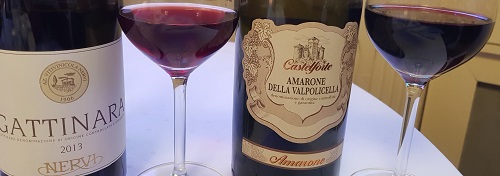What is Body?

Body is a description of how the wine feels in your mouth.
Normally, we talk about 3 categories:
- Light Body
- Medium Body
- Full Body
One way to think about the differences, is to think about:
- Water
- Skimmed milk
- Whole milk
Body = Weight
Body is a name for the weight of a wine. All fluids have a weight determined by the content.
The body is determined by 3 factors: Alcohol, Sugar, and Extracts
Alcohol is a contributor to the body because it gives the wine viscosity. (Water is less viscous than syrup. Water is lighter and moves more easily than syrup).
Sugar is also a factor that adds to the body. The more sugar, the more body.
Extracts are other factors. Extract are solids like tannins, glycerol, fat, and acid.
Viscosity
In wine, viscosity is expressed as body and weight.
Think about syrup or honey in your mouth: they feel thicker and move slower than water.
Or think about milk: skimmed moves more easily than whole or cream.
The main wine viscosity factor is alcohol: wines with 13,5% ABV and up tend to be full bodied.
Other viscosity factors are: residual sugar, glycerol, terroir, grape variety, vintage and temperature.
Sweet wines are more viscous than dry wines (more sugar).
High alcohol wines are more viscous than low alcohol wines.
Full body wines feel thick (heavy), light body wines feel thin.
Evaporation increases the viscosity: the more legs or the longer it takes to form, the more the viscosity.
In wine evaluation for viscosity, positive words are: fat, oily, meaty, supple, melting, thick.
Wine defect: lind (from Lindton, slimy), viscous.
Wine legs
Wine legs (aka tears, cathedral windows) are droplets formed inside the glass after swirling.
The scientific name is Marangoni effect.
This effect is due to alcohol evaporation and is completely eliminated if the glass is covered (preventing evaporation).
Because of this, it is incorrect to relate wine legs with wine quality.
The information that wine legs give us is the alcohol and sugar content (viscosity).
The higher the alcohol, the easier it is to form legs.
The higher the sugar, the slower the tears will flow down.
Red vs White
Red wines are more full bodied than white wines.
Dry white wines have a light or very light body (like lemonade).
Full bodied white wines are known as creamy nutty, or oily.
Off-Dry whites are also defined as full bodied whites.
Oaked vs Unoaked
Oaked red wines are more full bodied than unoaked reds.
Different winemaking techniques, such as leaving the wine longer with its skin also add body to a wine.
Most full bodied whites are oaked or malolactic or both.
Light Body Reds
Light Tannins. Good Acidity. Light Color.
| Beaujolais | |
| Vernatch | |
| Valpolicella | |
| Bourgogne | |
| Pinot Noir (France) | |
| Zweigelt | |
| St.Laurent | |
| Cinsalt | |
| Barbera | |
| Etna Rosso |
Medium - Light Body
Medium Tannins. Good Acidity. Medium Color.
| Cabernet Franc | |
| Garnacha | |
| Grenache | |
| Pinot Noir (Aged) | |
| Rioja Crianza | |
| Côtes du Rhône S | |
| Chianti |
Medium - Full Body
Medium Tannins. Balanced Acidity. Medium Color.
| Merlot | |
| Primitivo | |
| Ribera del Duero | |
| Sangiovese | |
| Bordeaux (R-Bank) | |
| Zinfandel |
Full Bodied Reds
High Tannins. High Alcohol. Strong Flavors. Dark Color.
| Aglianico | |
| Negroamaro | |
| Nero d'Avola | |
| Malbec | |
| Super Tuscan | |
| Bordeaux (L-Bank) | |
| Cab. Sauvignon | |
| Mourvèdre | |
| Languedoc | |
| Nebbiolo | |
| Barbaresco | |
| Syrah | |
| Crozes-Hermitage | |
| Shiraz | |
| Touriga Nacional | |
| Petite Sirah | |
| Pinotage | |
| Barolo |
Light Bodied Whites
- Chablis
- Chenin Black (Dry)
- Pinot Grigio
- Riesling (Dry)
- Vinho Verde
- Pinot Blanc
Medium Bodied Whites
- Albariño
- Bordeaux Blanc
- Riesling (Spätlese)
Full Bodied Whites
- Cardonnay (Oaked)
- Pinot Gris (Oaked)